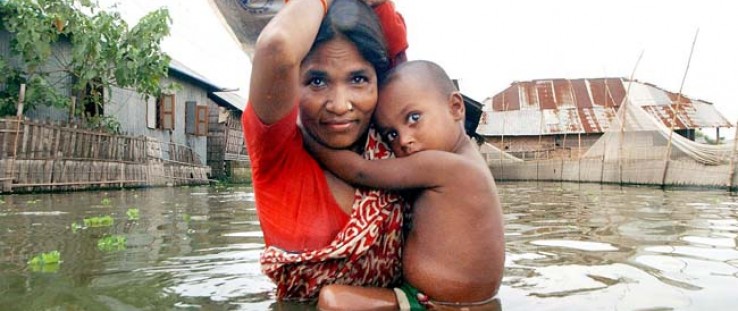 A mother carries her child in one hand and a packet of collected food in the other down a flooded road on the outskirts of Dhaka, Bangladesh, in August 2002.
Jewel Samad/AFP
A mother carries her child in one hand and a packet of collected food in the other down a flooded road on the outskirts of Dhaka, Bangladesh, in August 2002.
Jewel Samad/AFP
 A mother carries her child in one hand and a packet of collected food in the other down a flooded road on the outskirts of Dhaka, Bangladesh, in August 2002.
Jewel Samad/AFP
A mother carries her child in one hand and a packet of collected food in the other down a flooded road on the outskirts of Dhaka, Bangladesh, in August 2002.
Jewel Samad/AFP
It's difficult to imagine a country with greater energy needs and more acute climate vulnerability than Bangladesh. More than half of Bangladesh's 158 million people have no access to electricity, and the vast majority of those with access do not have a reliable or affordable supply. What's more, unmet electricity demand is growing at a rate of 10 percent per year. The shortage of reliable power limits the country's economic growth and contributes to high poverty rates. At the same time, climate change puts the lives of millions of Bangladeshis at risk and threatens to stall or reverse development gains over the last several decades.
On average, each flood in Bangladesh causes 148 deaths, affects 3.3 million people, and causes $186 million in damage. A single devastating flood in 2004 affected more than 36 million people and cost the country $2.2 billion. Because of its network of wetlands, rivers, and low-lying forests, Bangladesh is particularly prone to floods and storms—weather events that are expected to become more frequent and severe in the face of climate change.
For Bangladesh, and other developing countries, achieving long-term sustainable economic growth in the face of climate change and other threats is of primary concern. To help respond to this concern, in late 2010 the U.S. Government launched a program to help countries develop in a way that ultimately reduces greenhouse gas emissions growth and improves resilience to the effects of climate change.
“Much more than just a climate change or energy program, the Enhancing Capacity for Low Emission Development Strategies [EC-LEDS] program takes an economy-wide approach,” says Kit Batten, USAID global climate change coordinator. “It's really about sustainable economic growth.”
Low Emissions, High Impact
Gone are the days when climate change strategies and programs were confined to the science and environmental communities. With new international political will and support for green growth and sustainable development, climate change is now being integrated into longer-term economic development plans that target new opportunities for green investments and tap into new sources of climate finance.
Though the path to low-emissions development may follow a different route in each country, at its core EC-LEDS helps draw the blueprint for each country's green-growth strategy, partnering with key stakeholders to ensure that the final product meets the country's needs.
“Renewable energy development, energy sector reform—such as removing inefficient tariffs and subsidies—and national-level land and forest management are just some of the areas that the program might help developing countries map out in their own strategies,” says Bill Breed, USAID global climate change team leader.
Led by USAID and the State Department, the program also brings to bear the expertise of the U.S. Departments of Energy, Treasury, and Agriculture; the Environmental Protection Agency; the U.S. Forest Service; and other agencies, making it a true whole-of-government response to global climate change. It is a key component of the U.S. contribution to the pledge made by developed countries at the 2009 U.N. climate change negotiations to provide fast-start climate financing to developing countries by 2012.
Bangladesh was among the first U.S. partners in the program. After initial meetings between U.S. experts and the Bangladeshi Government, civil society, and other international donors to assess climate change and development strategies, government representatives are working to jointly map out an assistance plan. The plan identifies ways that the U.S. Government can partner with Bangladesh to help the country achieve a low-emissions pathway, for example, by helping it to update or improve national greenhouse gas inventories, conduct feasibility studies for renewable energy sources, or by sharing best practices in wild fisheries management to conserve wetlands.
A Different Low-Emissions Pathway
On the other side of the world, Mexico, another partner, has emerged as a developing country leader in the effort to promote green economic growth.
In 2007, Mexico established the Special Program on Climate Change, or PECC, which outlines more than 100 mitigation and adaptation objectives to be achieved through almost 300 actions carried out by multiple federal agencies. Some of these actions include: using the biogas generated by landfills, agricultural residues, and other sources for energy; switching out old appliances for energy-efficient models; converting to compact fluorescent light bulbs; and promoting alternative sources of income for forest dwellers.
The effort comes at a pertinent time for Mexico, with a growing economy with growing greenhouse gas emissions. Though considered a developing country, in 2010 it was ranked the 12th largest economy in the world. At the same time, it ranks 10th globally for carbon dioxide equivalent emissions.
“There is a huge potential for green growth in Mexico,” said Fernando Tudela, Mexican deputy secretary for environment and planning. “We would like to prove that a developing country can mitigate and adapt to climate change without hurting the economy. We want to prove that in Mexico.”
Generally speaking, EC-LEDS seeks to build upon existing climate change-related strategies. In Mexico's case, the government sought out U.S. assistance to help develop a mid-term strategy that builds upon and strengthens the PECC, ultimately enabling the country to transition from design to implementation.
As one example, USAID supported the development of software and provided training for a state-of-the-art electronic system called Carbon Counts to monitor Mexico's progress in implementing the actions laid out in the PECC and to track resulting emission reductions.
USAID is also helping Mexico identify which actions might be attractive for private sector investment. “Our earlier programs [such as support for Carbon Counts] have laid the foundations for our future EC-LEDS work in Mexico,” said Kay Freeman, USAID/Mexico acting mission director. “We will support the Government of Mexico as it establishes a transparent system for monitoring, reporting, and verifying the country's progress in reducing greenhouse gas emissions.”
“[EC-LEDS] is not only an integral part of the global effort to address climate change, but also a means of helping countries grow their economies, attract investment, encourage private sector growth, and achieve long-term, sustainable development,” said Michael Yates, then-senior deputy assistant administrator for USAID's Bureau for Economic Growth, Agriculture, and Trade at an event on the margins of the 2010 U.N. climate change negotiations in Cancun, Mexico.
Batten says the EC-LEDS program is “central to what we do [at USAID].” She emphasizes it as a key component of USAID's first-ever Climate Change Strategy, which is nearing completion.
“We recognize the importance to development of reducing emissions and climate vulnerabilities, and of incorporating climate change into USAID's overall development portfolio,” Batten said at a recent workshop.
“Through our development efforts, we want to build partner countries' abilities to respond to the needs of their citizens,” she said, “and reduce poverty effectively and sustainably in a changing climate.”
Although its focus is on specific countries, the EC-LEDS program is not limited by these borders. Another goal is to help build a shared global knowledge base on low-emission development. The United States is working with international organizations, leading technical institutions, and bilateral and multilateral donor agencies to ensure that LEDS-related programs are complementary rather than duplicative, and that they leverage the resources and expertise of other agencies and programs.
Incorporating lessons learned in Bangladesh, Mexico, and other initial partner countries, the program will work to develop partnerships on LEDS with 20 countries by 2013.







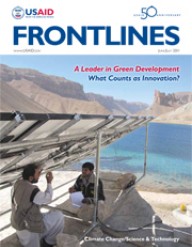

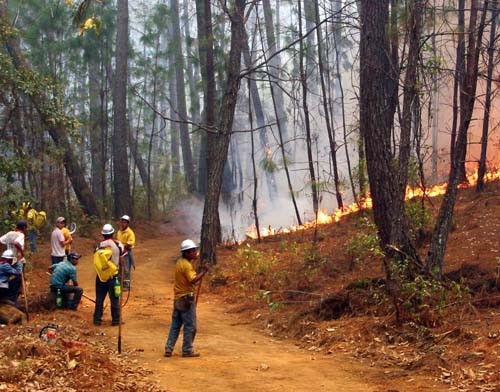
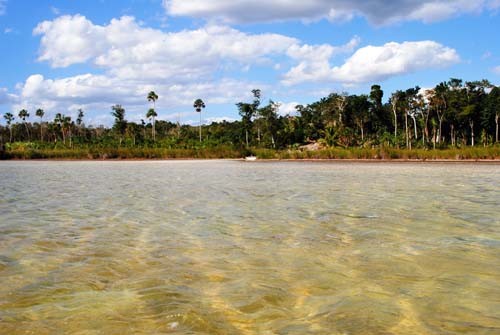
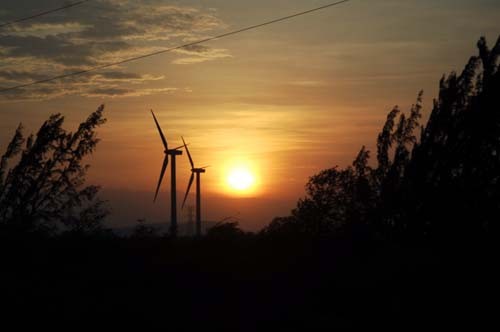
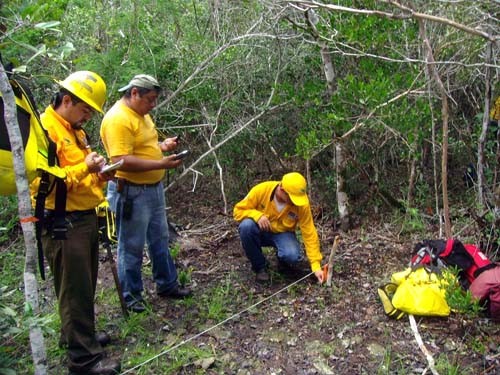
Comment
Make a general inquiry or suggest an improvement.